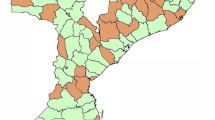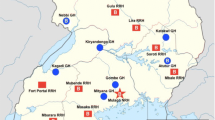Abstract
Background
This is a baseline assessment of surgical capacity in the Federal Capital Territory (FCT), in preparation for the creation of a National Surgical, Obstetric, Anesthesia, and Nursing Plan.
Methods
In October 2017, all 10 of the 11 secondary hospitals in FCT that provide surgical and/or obstetric care were surveyed using a modified World Health Organization Hospital Assessment Tool and a qualitative semi-structured hospital interview tool of the medical Director (MdD). This project received approval from the Nigeria Federal Ministry of Health and the FCT Department of Health and Human Services.
Results
The number of inpatient beds ranged from 35 to 140, and the number of admissions ranged from 1200 to 6400 patients per year. The mean number of surgeries performed in 2016 by these hospitals was 783 (range 235–1601). Cesarean section was the most common surgical procedure at each hospital. Only five hospitals regularly performed laparotomies. Only three hospitals regularly performed fixation of open fractures. Of 152 surgical, obstetric, and anesthesia providers, all hospitals had at least one consultant obstetrician, but only four hospitals had a general surgeon and three hospitals had a consultant anesthesiologist. Deficient physical space for inpatient admissions was the most common concern of MdDs.
Conclusions
The FCT reaches the target for 2-h access, with 80% of patients (on average) reaching the hospital within 2 h. However, SAO provider density, surgical volume, and tracking of the perioperative mortality rate were low. Data were lacking to comment on protection against impoverishing and catastrophic expenditures.


Similar content being viewed by others
Change history
11 December 2018
In the original article there is an error in Fig. 2. Following is the corrected figure:
References
Meara JG, Leather AJ, Hagander L et al (2015) Global surgery 2030: evidence and solutions for achieving health, welfare, and economic development. Lancet 386:569–624
O’Neill KM, Greenberg SL, Cherian M et al (2016) Bellwether procedures for monitoring and planning essential surgical care in low- and middle-income countries: caesarean delivery, laparotomy, and treatment of open fractures. World J Surg 40:2611–2619. https://doi.org/10.1007/s00268-016-3614-y
Kim YR, Kwakye G, Kwok AC et al (2015) Sustainability and long-term effectiveness of the WHO surgical safety checklist combined with pulse oximetry in a resource-limited setting: a two-year update from Moldova. JAMA Surg 150:473–479
Vivekanantham S, Ravindran RP, Shanmugarajah K et al (2014) Surgical safety checklists in developing countries. Int J Surg 12:2–6
Henry JA, Windapo O, Kushner AL et al (2012) A survey of surgical capacity in rural southern Nigeria: opportunities for change. World J Surg 36:2811–2818. https://doi.org/10.1007/s00268-012-1764-0
Okoye MT, Nguyen ET, Kushner AL et al (2016) Can economic performance predict pediatric surgical capacity in sub-Saharan Africa? World J Surg 40:1336–1343. https://doi.org/10.1007/s00268-016-3410-8
Krishnaswami S, Nwomeh BC, Ameh EA (2016) The pediatric surgery workforce in low- and middle-income countries: problems and priorities. Semin Pediatr Surg 25:32–42
Chirdan LB, Ameh EA, Abantanga FA et al (2010) Challenges of training and delivery of pediatric surgical services in Africa. J Pediatr Surg 45:610–618
Chukuezi AB, Nwosu JN (2010) Mortality pattern in the surgical wards: a five year review at Federal Medical Centre, Owerri, Nigeria. Int J Surg 8:381–383
Onyemaechi NO, Popoola SO, Schuh A et al (2015) Mortality pattern of hospitalized surgical patients in a Nigerian Tertiary Hospital. Indian J Surg 77:881–885
Ayoade BA, Thanni LO, Shonoiki-Oladipupo O (2013) Mortality pattern in surgical wards of a university teaching hospital in southwest Nigeria: a review. World J Surg 37:504–509. https://doi.org/10.1007/s00268-012-1877-5
Ekeke ON, Okonta KE, Igwe PO (2016) Surgical inpatient mortality in a Nigerian Tertiary Hospital. Niger J Clin Pract 19:308–312
Ekenze SO, Modekwe VO, Ajuzieogu OV, Asinobi IO, Sanusi J (2017) Neonatal surgery in a developing country: outcome of co-ordinated interdisciplinary collaboration. J Paediatr Child Health 53:976–980
Ilori IU, Ituen AM, Eyo CS (2013) Factors associated with mortality in neonatal surgical emergencies in a developing tertiary hospital in Nigeria. Open J Paediatr 3:231–235
Taliabi AO, Sowande OA, Adenekan AT et al (2018) A 10-year retrospective review of perioperative mortality in pediatric general surgery at Ile-Ife Hospital, Nigeria. J Pediatr Surg. Epub ahead of print
Ekwunife OH, Okpata A, Ugwu JO et al (2015) Outcome of neonatal surgeries in Nnewi, Nigeria. Ann Pediatr Surg 11:132–135
Idakwo U, Olawoye O, Ajayi BGK et al (2018) Exfoliation syndrome in Northern Nigeria. Clin Opthalmol 12:271–277. Figure reproduced from National Identify Management Commission: https://www.nimc.gov.ng/nimc-enrolment-centres/. Accessed 11 June 2018
Adapted from the Ministry of Land, Planning and Survey Abuja (2005) https://nigeriazipcodes.com/418/abujafct-zip-code-map/. Accessed 11 June 2018
World Health Organization (2012) Guide to infrastructure and supplies at various levels of health care facilities. http://www.who.int/surgery/publications/s15983e.pdf Accessed 15 April 2018
McCord C, Kruk ME, Mock CN et al (2015) Chapter 12: organization of essential services and the role of first-level hospitals. In: Disease control priorities, 3rd edn, volume 1 essential surgery. World Bank, Washington. http://dcp-3.org/sites/default/files/chapters/DCP3_Essential%20Surgery_Ch12.pdf Accessed 15 April 2018
National Population Commission (NPC) [Nigeria] and ICF International (2014) Nigeria Demographic and Health Survey 2013. NPC and ICF International, Abuja and Rockville
Acknowledgements
The authors thank the Federal Ministry of Health and the Federal Capital Territory Department of Health and Human Services for their assistance in this project. We also thank the National Hospital Abuja for their generous logistical support.
Funding
Dr. Anderson was funded through support from the Ronda Stryker and William Johnston Global Surgery Fellowship Fund at Harvard Medical School.
Author information
Authors and Affiliations
Corresponding author
Ethics declarations
Conflicts of interest
All authors declare that they have no conflict of interest.
Electronic supplementary material
Below is the link to the electronic supplementary material.
Rights and permissions
About this article
Cite this article
Anderson, J.E., Ndajiwo, A.B., Nuhu, S.A. et al. Assessment of Capacity to Meet Lancet Commission on Global Surgery Indicators in the Federal Capital Territory, Abuja, Nigeria. World J Surg 43, 704–714 (2019). https://doi.org/10.1007/s00268-018-4835-z
Published:
Issue Date:
DOI: https://doi.org/10.1007/s00268-018-4835-z




